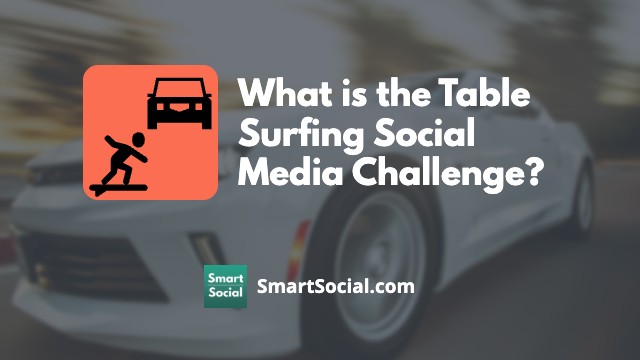6 Experts Share How to Audit a Student’s Online Presence
Green Zone App
(Click here to learn more)
Dangerous Social media challenge
(Click here to learn more)
Red Zone App
(Click here to learn more)
Gray Zone App
(Click here to learn more)

Students are going to be online no matter if their parents allow it or not. There’s no way to avoid it. But with the right attitude and communication, you can work with your teen to post content that will leave a glowing online presence for future employers and colleges to see.
We asked 6 experts to share how parents can perform a social media audit of their student’s digital footprint, how to handle any negative posts that come up, what positive content they should post, and how to continuously monitor their online presence.
1. Look through every post on every platform as far back as two years and longer
Denise Thomas, Get Ahead of the Class

Both colleges and employers will check their applicant’s and current employee’s social media. College acceptances have been rescinded and employees have been fired over finding derogatory or inflammatory comments and posts that are not in alignment with the college or company’s values.
Watch or listen to Denise and Josh discuss a social media audit and other tips
Knowing your own values is very important in deciding what is integral and important to you and who you are so that you can make decisions about what values you want to be connected to you and your social media accounts.
Parents should begin having this conversation as early as age 13, or even sooner. Have your teens write down a list of all of the platforms they have used and all the ones they use daily, but don’t assume that covers everything. There may be old profiles they have forgotten about. Then do a few Google searches for their name, their name and their city, and their name with their activities. This is just a starting point to auditing your student’s digital footprint.
On each social media platform check to make sure all of the details of the profile are correct and consistent with what you want to be public. Also, check for privacy settings in each. Platforms allow for certain personal information to be private as well as a limit on who can see your posts, however, nothing online is ever 100% private. Perform a general search for your student’s name on every social platform looking for potential fake or forgotten accounts.
Look through every post as far back as two years or more if you can. Both colleges and employers have been known to go back very far and the consequences of having derogatory statements can be disastrous even if those are not your views now.
If you do find something you don’t like, take action to have those items removed. If your teen posted it, they can delete it. If a friend tagged them, have them untag themselves or ask their friend to remove it from that platform.
Once you’ve found all the social sites your teen is on and have audited the content, make a note of the following information in a spreadsheet to make it easy to know where to start for your next audit:
- The social media platform name
- The URL directly to your teen’s profile
- Your teen’s profile name
- Number of followers/fans/friends
- Date of most recent activity
Teens should be cautioned against posting anything that would be considered controversial given the age of the teen (alcohol, drugs, intimate relationships, etc.). Also, use caution with politically or religiously controversial posts. What is politically correct and acceptable now can change even in just a month’s time.
All social profiles should be treated the same. This is your brand. Be consistent. You don’t want potential colleges or employers to question who you are or if they are looking at the wrong profile.
Now ask these questions to your teen:
- Why are you using this social media platform?
- What is important to you about using this platform?
- What are your goals for using it?
Most of the time having profiles on certain platforms is mostly because someone in their social circle suggested it. If they don’t have a need for it, it’s time to delete it.
I highly recommend being your student’s “friend” or follow them on every social media platform they are on (yes, this means having your own accounts on those platforms). The goal is not to participate, but to occasionally check in to notice if anything has been posted that would have a derogatory impact on your teen’s online presence. For example, your teen may be squeaky clean, but if they are tagged in a friend’s post with alcohol or drugs in that photo even if they did not attend the event, suddenly they are associated with that behavior.
You can also coach your student to not only scrutinize their social media for the bad but to also create an online presence that brands your teen in a positive way. Start a website. (The SmartSocial Student Branding Academy can guide your students in that process.)
Create a LinkedIn profile. Have them add positive photos and experiences that you want colleges, employers, and the public to see in your teen. Post photos volunteering in your community, and photos enjoying their favorite activities. They can also write articles on topics that interest them.
A student’s social media presence has the ability to enhance their college and employment applications or to destroy them. The bare minimum would be to check it once or twice per year, but more often when looking for a new employment opportunity.
2. Encourage students to be online and how important it is to be consistent across all platforms
Josh Ochs, Founder, SmartSocial.com

Avoiding social media is not the answer. Your student is going to have an online presence whether they like it or not, or whether they create it themselves or someone else creates it for them. Colleges and future employers will search for them and find those results. Students should be taking positive actions like building strong profiles, learning red flags to avoid, and making use of our “Green Zone” apps in order to Shine Online.
Explain to your student why it helps to use the same profile picture on all of their bio sections, provide the same information, and present a positive attitude that carries across all of their networks.
Start now! For today’s students, their online presence is dramatically changing the process of applying for college, internships, and jobs. The sooner you get started coaching them to create a positive reputation with their social media use, the better they’ll be set up in the future.
3. Share examples of how celebrities social media have cost them
JP Zhang, Founder, Software How

Knowledge is often key in helping people understand how important a thought-out online presence can be. This can be difficult to teach to students who don’t yet realize the impact of a negative presence, especially in the years to come.
Sometimes, a simple sit-down talk with a student, informing them that anything they put online can be public knowledge, can make them realize why they need to be careful. Share some of the many examples from celebrities we have seen get criticized for old Tweets. Let them know that no one is immune from the repercussions of old posts online. This disclaimer serves as a good reminder that can also instill just a little bit of fear.
An audit can also be an effective tactic, but it’s important to look at both the good and the bad aspects of a student’s social media presence. Find their posts that display positive aspects of who they are and where they want to go in life. It’s important to not just criticize their online presence. This positive reinforcement is often more effective in the long run.
Anything you can do to reach a student is an effective tactic. Rather than judge them or come off as too much of an authority figure, try a friendly, supportive approach.
4. Spend time with your student working on their self-image
Eric Chow, Chief Consultant, Mashman Ventures

The key to building a positive online presence is an internal positive self-image. If parents and educators can help students feel comfortable in their bodies and in themselves, they are far less likely to get involved in anything negative online. If they are secure in themselves and their life, they will be less likely to succumb to the pressure to post or share something online or to be insecure about showing the positive aspects of their life.
Parents should allow students to post what they enjoy talking about, but be aware of both political or religious undertones that could come back to hurt them later on in life. Social media is an opportunity to express oneself and connect with friends, so students should be able to do that freely and in a positive way. At the same time, if a parent wants to keep an eye on them, they should be looking for their behavior at home, any negativity online, or insecurity. If a student feels loved and cared for at home, respected for what they like, and they have a trusting relationship with you to not be judged when sharing, their posts online should reflect these feelings.
A student should post about:
- What they care about
- What they are interested in
- What they are passionate about
- Positive activities with their friends
If they feel insecure or judged, they should notice that and ask themselves why. Talking to an adult or older sibling about their feelings might help them understand why they feel that way.
It is also not a bad idea to step away from social media for a while. Go watch one of your favorite creators or inspirations who can help you feel better about yourself.
Remember these rules also: If you don't support it, don't post it. If you don't like it, don't talk about it.
5. Always separate your personal email from your professional email account
Carla Diaz, Cofounder, Broadband Search

Being one of the first people in my family to really dive into the on goings of the internet taught me a lot about how easy it is to discover yourself with online tools. As you begin to make your way into a career or internship, even if you scrub your accounts, something always lingers on the web.
One of the first tips I recommend students doing is to create two email accounts. One should be for your everyday things, like your streaming platforms or day-to-day social media. The other should be dedicated to your more professional or work-related messages. If you manage a website or online portfolio where you post content you create, such as art or photography, you would use this email as a contact email and one to share with prospective employers.
Another responsibility of being online is being familiar with how to erase content on the sites you use. This seems like more of a cheat, but it definitely beats leaving risky posts up for future career or admissions prospects to find and use to deny you. If you ever close a social media account you want to be sure the content is also deleted. Some platforms may give you a 30-day waiting period to delete your profile or just make it inactive rather than deleting it, so always read any text online very carefully.
6. "Google" your student and show them how much information you find publicly available online
Andrew White, Owner, Tech Gearoid
To find out what's out there about your student on the Internet, type their name in quotation marks into a search engine -- Google, Bing, Yahoo! -- and browse through the results. Use this as an opportunity to demonstrate to them that their digital imprint is quite real, even for casual internet users.
This activity isn't intended to scare students; rather, it's intended to demonstrate how open the Internet is. If they've engaged in cyberbullying or written a scathing blog post, you -- and millions of others -- will be able to locate it. Parental control software is an excellent tool for parents who want to keep an eye on their student's use of social media and the internet, but it is not a catch-all for their activity.
If your internet search yielded results, particularly if dubious sites appeared, your next step is to help your student manage their online presence. Establish a list of all internet accounts they are on or you are aware of, go through them together, and have them remove any ones they no longer use or consider superfluous.
If you are struggling to remove an account, at the very least modify the information so that it no longer has any ties to personal data. If your student has left comments on blogs or web pages, you can ask the site owner to remove their comment and information from their site by contacting them directly - usually through the Contact Us or About Us sections. If a student becomes or has been the victim of doxxing or has discovered their sensitive personal information on the Internet, you can contact Google and ask them to delete it from search results.
Conclusion
What a student writes online today may not surface for years to come, but if it’s a controversial or sensitive topic, that one post has the power to wreck an entire career. Colleges and employers can no longer take risks when accepting students into their programs because of how quickly news travels online and how much damage bad PR can cause them. Audit your student regularly and ensure that their friends are on board as well in helping everyone Shine Online.
Protect your family and enter for a chance to win cool prizes
Become a member or log in to learn more on this topic
Protect your family and enter for a chance to win cool prizes

., start learning from this page to earn points!*
Hello, I'm Josh, the founder of SmartSocial.com.
Don't leave this page until you fill out our feedback form that will appear after you learn from the resources...
Here are some of the latest resources at SmartSocial.com
Become a Very Informed Parent (VIP) to get our social media suggestions in your email every Tuesday & Thursday.



Hello, I'm Josh, the founder of SmartSocial.com. Protect your family by taking my 1 minute quiz
This quiz will help you understand how safe your family is


Schools & Districts: Partner with us to protect your community online
Our remote presentations (and website) teach over a million parents and students each year how to be safe so they can shine online. We teach students how their accounts can be used to create a portfolio of positive accomplishments that impress colleges and employers.


Join Our Smart Social Podcast
each week on iTunes
With over 500 episodes, Josh Ochs interviews psychologists, therapists, counselors, teachers, and parents while showing you how to navigate social media to someday shine online.
Listen on:



.jpg)
.jpg)

.jpg)


